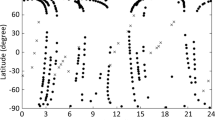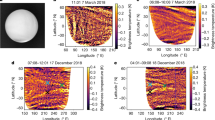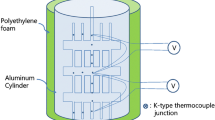Abstract
THE resistance of the air to a moving object like a satellite causes a steady decrease of the semi-major axis and eccentricity of the orbit. The motion of the satellite grows faster and the satellite itself submerges deeper and deeper into the atmosphere at every revolution. When the satellite has descended to a certain level, where the heating from impact of air molecules on the frontal surface becomes great enough, the satellite burns out. For the purposes of ephemerides and for the prediction of the life-time of the satellite, it is necessary to know how its orbital elements will be changed by the resistance of the air—supposing that we have some knowledge of the density of the air at the height where the satellite is moving, and of the drag coefficient of the satellite. Unfortunately, these data are not usually known with sufficient accuracy. But we can reverse this problem and search for a solution of how the air density could be determined from observed changes in size and shape of the orbit when the drag coefficient of the satellite is known. If we do not know this drag coefficient (which depends on the size, shape and mass of the satellite), we can still determine at least the gradient of the air-density. G. V. Groves published two valuable papers1,2 last year, in which very accurate methods for such a determination have been developed. The only assumption made here, which could be accepted as a general approximation, is that air-density varies with height according to the relation:  where ρ00 is the density of the air at the height h
00, H
1 is the scale-height in the case of an isothermal atmosphere, and H
2 enables us to take account of the variation of atmospheric temperature with height. From the data of six different satellites with perigees between 180 and 650 km., Groves has found that, for h
00 = 200 km.:
where ρ00 is the density of the air at the height h
00, H
1 is the scale-height in the case of an isothermal atmosphere, and H
2 enables us to take account of the variation of atmospheric temperature with height. From the data of six different satellites with perigees between 180 and 650 km., Groves has found that, for h
00 = 200 km.:  In the second paper, methods have been developed for the determination of H
1 and H
2 without any knowledge of the drag coefficient. In this case, of course, the determination of ρ is not possible.
In the second paper, methods have been developed for the determination of H
1 and H
2 without any knowledge of the drag coefficient. In this case, of course, the determination of ρ is not possible.
This is a preview of subscription content, access via your institution
Access options
Subscribe to this journal
Receive 51 print issues and online access
$199.00 per year
only $3.90 per issue
Buy this article
- Purchase on Springer Link
- Instant access to full article PDF
Prices may be subject to local taxes which are calculated during checkout
Similar content being viewed by others
References
Groves, G. V., Proc. Roy. Soc., A, 252, 16 (1959).
Groves, G. V., Proc. Roy. Soc., A, 252, 28 (1959).
Author information
Authors and Affiliations
Rights and permissions
About this article
Cite this article
BOCHNÍČEK, Z. Profile of Upper-Atmosphere Air Density at the Height 180–212 km. derived from the Orbit of Sputnik III. Nature 186, 460–461 (1960). https://doi.org/10.1038/186460a0
Issue Date:
DOI: https://doi.org/10.1038/186460a0
Comments
By submitting a comment you agree to abide by our Terms and Community Guidelines. If you find something abusive or that does not comply with our terms or guidelines please flag it as inappropriate.



